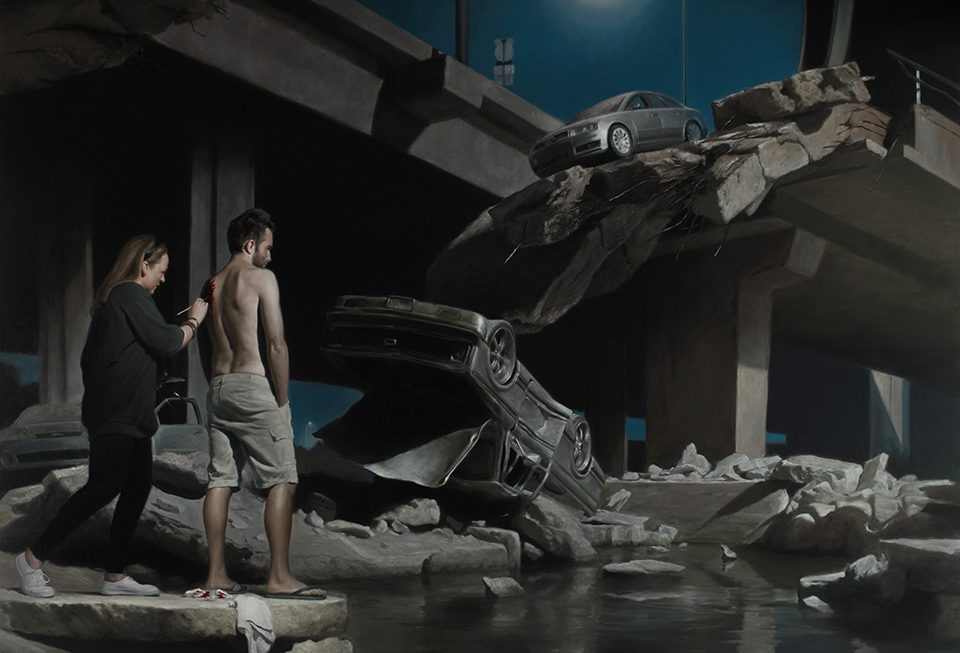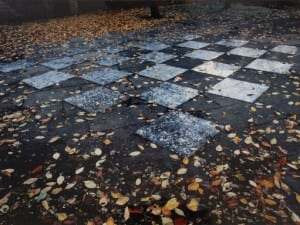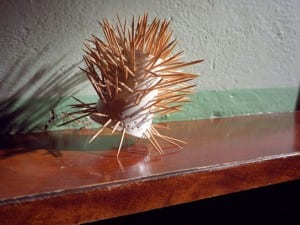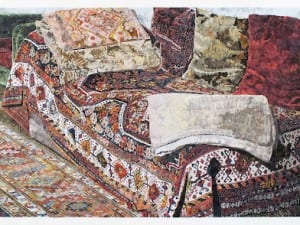Jonathan Wateridge’s latest show opens at All Visual Artists. It depicts scenes from an imaginary film creating interplay between narratives of fact and fiction.
Jonathan Wateridge paints on a large scale, producing grandiose scenes that are part painting, part theatre set, and dominate the galleries that show them. Previous images of plane crashes or posed groups have managed to insinuate themselves into the artistic ether, showing up in exhibitions, on websites and being talked about suddenly, as if they have sprung from nowhere to high regard. Another Place, his latest sequence of seven paintings, opened on the 3 June at All Visual Artists in London. Given the level of acclaim so far garnered, there is a lot of excitement about this show, which will likely mark his debut as a new star in British painting. Wateridge has the courage to directly plunder the most despised and anachronistic aspects of historical painting to produce work that could be the most exciting reinvigoration of the discipline yet.
The paintings in Another Place are certainly large: seven canvases each measuring 3 x 4 metres, and thematically linked to some imaginary movie set in the great cultural trope of Southern California. Each grand scene is recognisable – the set of a crime film, a poolside party, garage sale in a front garden – from the endless media output of Los Angeles, but also completely anonymous and linked only, if at all, to others in the series. They are also a fascinating blend of mildly repulsive, yet utterly absorbing. The most obvious parallels are photographers Philip-Lorca diCorcia, with his ability to poetically capture the mundane whilst hinting at something bigger, and Larry Sultan, whose images are packed with narrative clues that contrive to appear empty. With Another Place however, Wateridge seems intent on monumentalising the mundane whilst leaving the viewer in no doubt that something huge is about to happen. If you try very hard you can almost smell it coming.
In that way, his work also recalls big historical scene-stealers like Rembrandt’s Night Watch where composition, technique and scale transform an animated group portrait into an image so epic we remain transfixed over three and a half centuries later. Whether or not Wateridge’s examination of the great Californian myth will similarly enthral is a moot point, but already it is worth noting how his work revives archaic history painting, putting it at the service of Hollywood, that current nadir of cultural attainment, by composing credible narrative scenes from portraits of individuals pretending to be actors who pretend to be others. The point is of course the way he convincingly mixes the anachronistic with the brand new, reinvigorating both.
The artist confirms this when discussing his influences: “Artistically, my first loves are still very much the same today – the likes of Manet, Goya, Rembrandt and Velasquez. I have always felt a profound kinship with their realism, despite believing it impossible for a long time to engage directly with this kind of work in a contemporary context.” Within months of starting college, he abandoned painting altogether, deeming it hopelessly old-fashioned and deciding the only way forward as a progressive, young artist was by making highly conceptual work expressed purely through contemporary media. His clear change of heart and return to painting happened only after years of exploring various ways of working – via conceptualism, filmmaking and even theatre. “In retrospect, I was laying the foundations of much of what I do now, slowly being drawn back to pure image making because, for one, I really missed not having a material process.” It was only after spending a few years making highly labour intensive images out of pigment dissolved in wax on glass – an awkward hybrid of painting, film and photography that he considered the possibility of painting again: “Finally, I was liberated to actually make the work I wanted to, and it’s been a long haul to establish a way in which to make large scale realist images that I felt could be viable in a contemporary context.” Ironically, he has come to realise that the obsolete aspects of painting he once found so distasteful they drove him to abandon it are now the very elements that are most exciting to exploit.
Exhibiting over the last five years, Wateridge has previously shown large-scale paintings depicting, amongst others, posed Sandinistas or a crashed plane in the jungle, both now in the Saatchi Collection. The paintings of Another Place, presented as a sequence, all depict scenes from a fictional American film that is centred on an unseen catastrophic event, thereby inviting the viewer to guess the nature of this particular calamity. One painting shows a wound being painted onto an actor near a collapsed road bridge, giving a clue to the scale of the disaster, but leaving it ambiguous as to whether the scene is a recorded construct or supposed reality. Within each picture there are smaller and more private disasters occurring whose relationship to the bigger, offstage catastrophe is unclear: an architect “dies” on a film set, a security guard falls in a department store at night, an anxious telephone call is received in a domestic kitchen and a woman stands before a house with furniture and possessions heaped around. We have no clear indication if, for example, the last one is about eviction or a garage sale. All of these potential stories happen in and around the greater narrative of Another Place, and each figure portrayed gives clues to further meta-narratives of class and economic status, as well as ideas about the construction and fluidity of identity. All of which, in the absence of any storyline proof, allied with a growing awareness of the artist’s desire to provoke ambiguity in the viewer, soon makes this series of paintings appear far richer than afforded by initial impressions. Another Place, with the constant presence of something bigger beyond each image and hints of a network of interconnected stories, could perhaps be described as a hybrid of Philip-Lorca diCorcia’s A Storybook Life, where images taken over two decades are edited and sequenced to suggest something similar, and Robert Altman’s grand ensemble feature films such as Nashville or Short Cuts.
This leads to speculation about what the artist’s relationship is with America, which is clearly the setting for these images. He acknowledges that, despite being a British person who spent the first part of his life growing up in Africa and the rest primarily in London, he has probably spent a good part of it inhabiting the imaginary landscape of American film. Wateridge says: “As a product of cultural osmosis, I often feel I experience the world second-hand, via the constant flow of imagery that has shaped us all over decades. There is absolutely nothing unique in that, in the same way that there is nothing unique in the subject matter I choose for the paintings. In fact, it’s their very familiarity that interests me. Aside from that, I found the notion of setting the series within a fictionalised version of what is essentially Los Angeles, very resonant. Not only is it literally at the edge/end of the Western world, it also the ‘city of dreams’ made palpable through cinema.”
Wateridge articulates the great modern truth that all countries are new when you first visit them, but thanks to television and cinema, we are all familiar with the United States before we get there. Our contemporary cultural landscape is dominated by America to the point where it is the main reference point for our lived reality: just as it can be argued that visual culture not only records reality but creates it, so these created ideas are profoundly informed by a modern American vision. Thus contemporary realism is, effectively, American, and Jonathan Wateridge merely records this fact. By itself, this would not be particularly remarkable, but when allied with the artist’s passionate belief in historical and history painting, it adeptly recruits an old tradition to make exceptional modern paintings. It is rare to hear anyone talk with such conviction and clarity about their favourite great historical painters as Wateridge does on the subject of Courbet and Manet, who he believes have more contemporary relevance than many who followed them. “Manet’s work, particularly in the 1860s before he succumbed to the increasingly formalist aspects of Post-Impressionism, was very socially and politically aware. He was making realist paintings on his terms that engaged with the world around him in an investigative and exploratory way. That was an exciting and unique place for an artist to be and his work of that period is some of the greatest I’ve seen, but it was a brief window. Very simply, the rise of formalism within painting mirrored the appropriation of the real by photography and the rest becomes the history of Modernism.” The way art echoes through history, however, is not necessarily linear, and he acknowledges that he finds extraordinary parallels between, for example, Gerhard Richter and aspects of Degas’ relationship to paint and photography. He also notes how Sickert’s late work seems incredibly contemporary next to other artists of the time who notionally would have been considered more “avant-garde” but is suspicious of the term itself as: “It is reliant on a romantic binary opposition that no longer exists and I believe we are working in a far more interesting and fluid context than that.”
Wateridge’s painstaking, picture-perfect technique results in paintings that look almost like photographs, but the artist himself puts this down to seeing his work in reproduction as, once a painting has been photographed, it becomes more “photographic”. Borrowing once more from the vocabulary of classical painting, he defines himself as a realist painter rather than a photo-realist. “Photo-realism for me is about the transposition of information that relates to the particular way a camera sees. I try to paint as the eye might see, which is more contingent, fleeting, variegated and more edited in terms of the information that remains. For me there’s an absence and certainly a distancing within any photo-realist image, whereas I try to compose and render the figures in a way that makes their presence as palpable as possible. Photography allows the possibility of the cinematic to enter the paintings, but their rendering has to be about exploring and celebrating the materiality of paint rather than denying it, which in my experience much photo-based painting tends to do.”
There is also an important distinction to be made between the reading of surface symbolic meanings and their material embodiment and this again finds its simplest form in the difference between a reproduction and the painting itself. Most significantly it is at the heart of the question as to why, for example, Wateridge’s images are paintings and not photographs. Painting as an art form is not beholden to the everyday, and it is not a marker for the “real” in a way that photography is, despite the ability of digital technology to manipulate its content. Therefore the uncanniness or “convincingness” of painting can become even more striking because today it is almost unexpected. If the figures in these paintings were photographs, they would more readily be accepted as “reality” and the set up as a staging, and the whole thing understood as a play on a cinematic moment, the viewer would more easily “get the point”. But once it has all been worked up into a painted image, those boundaries are blurred and the viewer’s knowingness is removed. Ironically, the viewer comes to believe in the image precisely because it is a painting and not a photograph.
This explains why he paints as he does, and contrary to much received art-historical wisdom, believes that history painting is still a viable, worthwhile and creative practice, merely requiring different terms of use today. Everyone knows adaptation means survival, and Wateridge applies this to his craft, reminding us how painting becomes very interesting at the point where it becomes aware of its own limitations: “I am not doing anything new in this respect and have taken great courage from the fact that artists such as Gerhard Richter and Luc Tuymans have done so much to redefine the terms under which it becomes possible to paint. The climate has certainly thawed somewhat within the art world as even five years ago I think my work might well have been dismissed.”
The exhibition ran from 4 June – 3 July 2010 at All Visual Artists. www.allvisualarts.org.
David Gleeson





